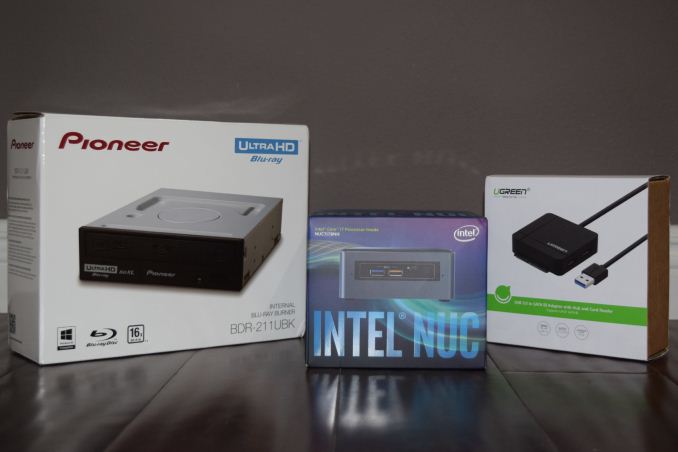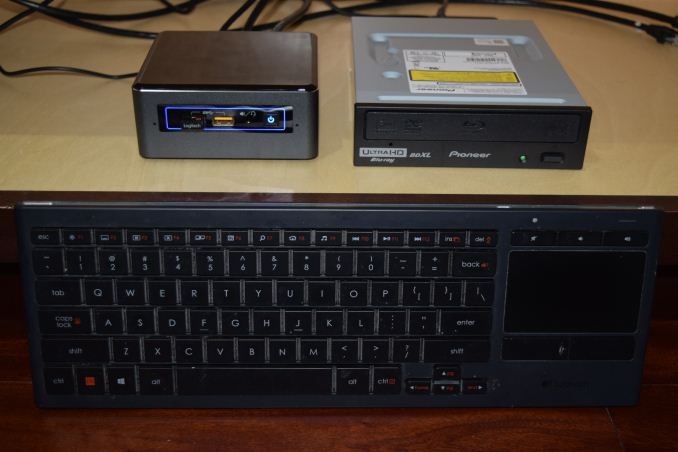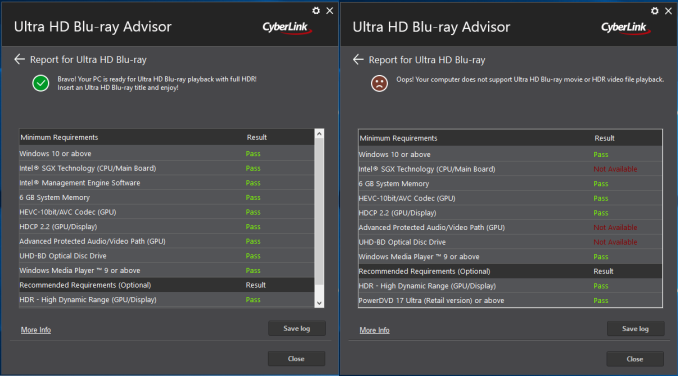A Budget Home Theater & PC Setup: 4K, HDR, UHD Blu-ray, and More
by Ganesh T S on December 26, 2017 8:30 AM ESTConfiguring a UHD Blu-ray Playback System
The rise in popularity of OTT streaming has coincided with a decline in the popularity of physical media formats such as Blu-rays. Irrespective of the market statistics, it is indisputable that the bitrates possible with the latter simply can't translated to OTT services. Bitrates usually directly correlate with video quality, though, beyond a certain point, it becomes very difficult to distinguish. HD audio formats such as Dolby Atmos, DTS-HD MA, Dolby TrueHD etc. are also yet to be widely adopted by OTT streaming services. On top of all these, Blu-rays are often treated as collectibles by some consumers.
UltraHD (UHD) Blu-rays (with their 4K resolution videos encoded in HEVC) were a bit slow to take off. On the PC front, the number of licensed software Blu-ray player vendors has come down from 3 (ArcSoft, Corel, and CyberLink) to just CyberLink alone. PowerDVD 17, with UHD Blu-ray support, was released in April 2017. The hardware requirements were quite specific, and we decided to pass up on a hands-on review at that time.
While reviewing the Intel NUC7i7BNH, I realized that it came with support for SGX, one of the primary requirements for PowerDVD 17 to play back UHD Blu-rays. I also remembered that the BIOS of the ASRock Beebox-S 7200U had a SGX option. Both of these systems also had a LSPCon on board to support HDMI 2.0 with HDCP 2.2 capability. Pioneer launched the BDR-211UBK in March, but, had specifically indicated that KBL-U was incompatible. However, based on our discussions with both CyberLink and Intel, we decided to give the drive a try by connecting the internal SATA ODD using a compact SATA-USB bridge.
The Pioneer BDR-211UBK and the UGREEN SATA-USB Adapter Combine to Make the Intel NUC7i7BNH a UHD Blu-ray Player
We looked up Amazon for a compact bridge and chanced upon a versatile UGREEN adapter. In addition to supporting the SATA drive, it also had a couple of USB 3.0 Type-A extension ports and a microSD reader. This made sure that the optical drive would not completely take over the USB port in the host system.
Using an Internal Drive without an Enclosure is not an Issue if the Setup is Tucked Out-of-Sight
After setting up the hardware and configuring the BIOS appropriately in the two systems, we installed the Management Engine components. The next step was to confirm that the system and allied components were correctly set up for UHD Blu-ray playback with HDR. CyerbLink provides the Ultra HD Blu-ray Advisor tool for this purpose. It also helpfully points out missing ME components or mis-configured BIOS options. Even though we were aware that the Zotac ZBOX MAGNUS EN1080K doesn't pass the requirements check (no SGX, iGPU inactive), we did try out the tool on it also.
The CyberLink Ultra HD Blu-ray Advisor (L: ASRock Beebox-S 7200U, R: Zotac ZBOX MAGNUS EN1080K)
Even though it is possible that the Zotac EN1080K might enable SGX in a future BIOS release, the use of the Intel GPU is probably disabled at the board level. This means that there is no protected audio/video path for secure decoding of the UHD Blu-ray streams. Given that there is no talk of UHD Blu-ray support from NVIDIA Pascal, consumers shouldn't keep their hopes up regarding the possibility of UHD Blu-rays getting played back on NVIDIA Pascal-equipped systems. Coming back to the results of the UHD BD Advisor tool, we find that the two KBL-U systems pass all the checks. We purchased a retail copy of the Planet Earth II UHD Blu-ray for testing out our setup.













191 Comments
View All Comments
Golgatha777 - Tuesday, December 26, 2017 - link
It doesn't even make financial sense to try and do 4k Blu-ray on PC. The optical drive is $117 and the playback software, PowerDVD 17 is $40 currently. Add to this the requirement for specific motherboards and CPUs for the DRM chain, and you've more than paid for an XBox One S.Not to mention from my anecdotal experiences during the Bluray days, the software will be buggy as hell, the audio will be a pain in the ass to configure correctly, and you'll need to update the software (in this case PowerDVD) to the newest version down the road to keep up with the DRM key refreshes.
I built a HTPC years ago, and it's only still useful because I also use it to game on, and because of software that strips DRM off my discs. Now that commercial playback software must support Cinavia, it's useless to me as well for playing back ripped ISO images and media files; so I turn to open source programs and will keep my old hardware that ignores Cinavia, etc. for playback. For streaming and 4k discs, and XBox One S is much more cost effective, and the playback software will get updated for free going forward (support for new DRM keys, Dolby Vision, Dolby Atmos, etc.).
Golgatha777 - Tuesday, December 26, 2017 - link
Forgot the $26 for a SATA breakout drive enclosure for the 5.25in optical drive.edzieba - Tuesday, December 26, 2017 - link
For regular BD playback, by far the most painless experience is to just use AnyDVDHD and play the movie file directly off of the disc. No mucking about with menus (and waiting for a Java VM to load up just to RUN the menus!), no dealing with the steaming pile of garbage that is PowerDVD, no worrying about having to have an obtuse HDCP compatible chain, etc.Recent developments have shown HDCP 2 is on the way to being broken in a similar way, so soon the only practical requirements may be a BDXL capable drive and a HDR capable monitor/TV.
Fujikoma - Thursday, December 28, 2017 - link
I rip everything to an NAS and strip the Cinavia out of it. It also saves me the hassle of getting off my lazy butt and I can just stream anywhere in my house without a problem. My 4k BD drives cost me less than $70 (LG) and they both work fine for ripping (1950X TR with NVidia 1080). I can use my XBoneS for the odd video files (format, audio and sub options) I have and the Roku (boxes and the t.v. built-ins) work just fine for my h265 MP4s. I think you're right that the XBone platform would be a better option for 4k at this point. I'd use a 4k dedicated player for family, if no one games because it's less complicated. With family, fewer remotes and components has been the way to go. That's why I keep the amps and pre-amp setup in my computer room.The article, itself, doesn't really make any sense because there's too much skimping on the home theatre. Just easier to start with a good t.v. and audio setup with front speakers only, then add in the extra bells and whistles later. The list doesn't even contain a sub... which means a decent sound bar would be viable option to ceiling speakers as the surround setup isn't even in the cost breakdown.
rapster - Sunday, December 31, 2017 - link
How do you strip out Cinavia? Last I heard there still wasn’t a viable solution and would be very glad to hear that the situation has changed.Fujikoma - Sunday, January 7, 2018 - link
I'm not going to list the software, as it already had a run-in with the U.S. govt. and I don't feel like causing myself more hassle again even though I have a legal right to rip my own BD/DVD collection. Considering I (as does everyone in the U.S.) pay a 'fine' to the recording industry every time I purchase recordable/storage media for potential pirating/format change of stuff I own, my attitude towards it is even more jaded. Needless to say, the software was worth the money.Aikouka - Wednesday, December 27, 2017 - link
I wouldn't just flat-out recommend the Xbox One to anyone as a UHD BR player. The Xbox One's biggest problem is that it's far too noisy when playing UHD Blu-rays (disc noise), and it's quite easy to hear during quieter parts of a movie. I went that route to start with, and it only took me one movie to start researching alternatives. Unfortunately, most alternatives have issues too. Sony's player is arguably the one that has the least amount of awkward teething issues, but it'll never support Dolby Vision. (TCL's P605/P607 supports Dolby Vision.) LG was supposed to add it, but they pulled the update. I've also heard complaints of noise from other players. The only player that seems to get decent praise is Oppo's 203, but it's also over twice as expensive as the others (~$500).edlee - Thursday, December 28, 2017 - link
I understand the superiority of Dolby Vision, but the fact that its not widely supported in the tv market, only LG, roku tv, and vizio support the feature. All the support is going to the forthcoming HDR10+, i know its difficult to review right now, but its an open standard and royalty free. You will see support for it from more tv manufacturers as well. It has streaming support from Amazon on over 100 titles, and support is mostly coming from Netflix in the future.Reflex - Thursday, December 28, 2017 - link
And honestly until you get to 80" or higher projector style setups DV is unlikely to make a noticeable difference in image quality. DV is a nice to have, but not at all mandatory for a first class experience, at least not yet.HStewart - Friday, December 29, 2017 - link
I actually have Xbox One S and primary used it for UHD Blu-rays. There is difference in having it on PC then on Xbox - because you can also used it as 4K Monitor which is good fro graphics programs.I would agree for low cost it best to go for Xbox One S ( or X ).
I would think with this Pioneer drive - you should be able to get HULU in 4k on PC - but even with the Xbox you will need 13 megabit Internet connection to run 4k HULU.